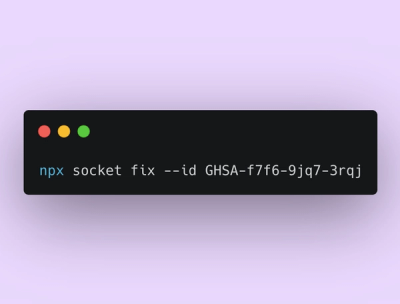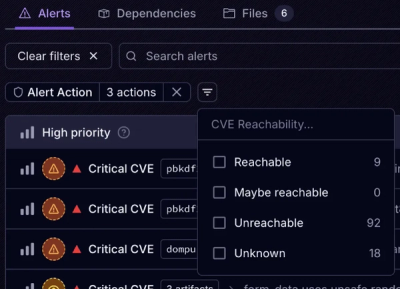
Product
Announcing Socket Fix 2.0
Socket Fix 2.0 brings targeted CVE remediation, smarter upgrade planning, and broader ecosystem support to help developers get to zero alerts.
react-joyride-with-next
Advanced tools
npm install --save react-joyride
Include Joyride in the parent component.
var react = require('react');
var Joyride = require('react-joyride');
var App = React.createClass({
render: function () {
return (
<div className="app">
<Joyride ref={c => (this.joyride = c)} steps={this.state.steps} debug={true} ... />
<YourComponents .../>
</div>
);
}
...
});
Don't forget to pass a ref to the component.
If your are using SCSS (and you should):
@import '../path/to/node-modules/react-joyride/lib/styles/react-joyride'
Or include this directly in your html:
<link rel="stylesheet" href="react-joyride/lib/styles/react-joyride-compiled.css" type="text/css">
Add a custom function to include steps to your state in your own component
addSteps: function (steps) {
let joyride = this.joyride;
if (!Array.isArray(steps)) {
steps = [steps];
}
if (!steps.length) {
return false;
}
this.setState(function(currentState) {
currentState.steps = currentState.steps.concat(joyride.parseSteps(steps));
return currentState;
});
}
addTooltip(data) {
this.joyride.addTooltip(data);
}
Add steps/tooltips after your components are mounted.
componentDidMount: function () {
this.addSteps({...}); // or this.addTooltip({...});
this.joyride.start();
// or using props in your child components
this.props.addSteps({...});
}
...
render: function () {
return (
<div>
<Joyride ref="joyride" .../>
<ChildComponent addSteps={this.addSteps} addTooltip={this.addTooltip} />
</div>
);
}
Or you can start the tour after a criteria is met
componentDidUpdate (prevProps, prevState) {
if (!prevState.ready && this.state.ready) {
this.joyride.start();
}
},
Please refer to the source code of the demo if you need a practical example.
You can change the initial options passing props to the component. All optional.
debug {bool}: Console.log Joyride's inner actions. Defaults to false
keyboardNavigation {bool}: Toggle keyboard navigation (esc, space bar, return). Defaults to true
locale {object}: The strings used in the tooltip. Defaults to { back: 'Back', close: 'Close', last: 'Last', next: 'Next', skip: 'Skip' }
resizeDebounce {bool}: Delay the reposition of the current step while the window is being resized. Defaults to false
resizeDebounceDelay {number}: The amount of delay for the resizeDebounce callback. Defaults to 200
scrollOffset {number}: The scrollTop offset used in scrollToSteps. Defaults to 20
scrollToSteps {bool}: Scroll the page to the next step if needed. Defaults to true
scrollToFirstStep {bool}: Scroll the page for the first step. Defaults to false
showBackButton {bool}: Display a back button. Defaults to true
showOverlay {bool}: Display an overlay with holes above your steps (for tours only). Defaults to true
showSkipButton {bool}: Display a link to skip the tour. Defaults to false
showStepsProgress {bool}: Display the tour progress in the next button e.g. 2/5 in continuous tours. Defaults to false
steps {array}: The tour's steps. Defaults to []
tooltipOffset {number}: The tooltip offset from the target. Defaults to 30
type {string}: The type of your presentation. It can be continuous (played sequencially with the Next button) or single. Defaults to single
disableOverlay {bool}: Don't close the tooltip on clicking the overlay. Defaults to false
callback {function}: It will be called after:
{ type: 'step:before', step: {...} }{ type: 'step:after', step: {...} }{ type: 'overlay', step: {...} }{ type: 'finished', steps: [{...}], skipped: boolean }Defaults to undefined
completeCallback {function}: It will be called after an user has completed all the steps or skipped the tour and passes two parameters, the steps {array} and if the tour was skipped {boolean}. Defaults to undefined
stepCallback {function}: It will be called after each step and passes the completed step {object}. Defaults to undefined
Example:
<Joyride
ref="joyride"
steps={this.state.steps}
debug={true}
type="single"
callback={this.callback}
...
/>
Add tooltips in your elements.
data {object} - A step object (check the syntax below)Call this method to start the tour.
autorun {boolean} - Starts the tour with the first tooltip opened.Call this method to programmatically advance to the next step of the tour.
Call this method to stop/pause the tour. Call this.joyride.start(true) to restart.
Call this method to reset the tour iteration back to 0
restart {boolean} - Starts the new tour right awayRetrieve the current progress of your tour. The object returned looks like this:
{
index: 2,
percentageComplete: 50,
step: {
title: "...",
text: "...",
selector: "...",
position: "...",
...
}
}}
Parse the incoming steps, check if it's already rendered and returns an array with valid items
steps {array|object}var steps = this.joyride.parseSteps({
title: 'Title',
text: 'description',
selector: 'my-super-class',
position: 'top'
});
// steps
[{
title: 'Title',
text: 'description',
selector: '#super-panel',
position: 'top'
}]
There are a few usable options but you can pass custom parameters.
title: The title of the tooltiptext: The tooltip's body text (required)selector: The target DOM selector of your feature (required)position: Relative position of you beacon and tooltip. It can be one of these:top, top-left, top-right, bottom, bottom-left, bottom-right, right and left. This defaults to top.type: The event type that trigger the tooltip: click or hover. Defaults to clickExtra option for standalone tooltips
trigger: The DOM element that will trigger the tooltipYou can style tooltips independently with these options: backgroundColor, borderRadius, color, mainColor, textAlign and width.
Also you can style button, skip, back, close and hole individually using standard style options. And beacon offset, inner and outer colors.
Example:
{
title: 'First Step',
text: 'Start using the <strong>joyride</strong>', // supports html tags
selector: '.first-step',
position: 'bottom-left',
type: 'hover',
style: {
backgroundColor: 'rgba(0, 0, 0, 0.8)',
borderRadius: '0',
color: '#fff',
mainColor: '#ff4456',
textAlign: 'center',
width: '29rem',
beacon: {
offsetX: 10,
offsetY: 10,
inner: '#000',
outer: '#000'
},
button: {
display: 'none'
// or any style attribute
},
skip: {
color: '#f04'
},
hole: {
backgroundColor: 'RGBA(201, 23, 33, 0.2)',
}
...
},
// custom params...
name: 'my-first-step',
parent: 'MyComponentName'
}
$joyride-color: The base color. Defaults to #f04$joyride-zindex: Defaults to 1500$joyride-overlay-color: Defaults to rgba(#000, 0.5)$joyride-beacon-color: Defaults to $joyride-color$joyride-beacon-size: Defaults to 36px$joyride-hole-border-radius: Defaults to 4px$joyride-hole-shadow: Defaults to 0 0 15px rgba(#000, 0.5)$joyride-tooltip-arrow-size: You must use even numbers to avoid half-pixel inconsistencies. Defaults to 28px$joyride-tooltip-bg-color: Defaults to #fff$joyride-tooltip-border-radius: Defaults to 4px$joyride-tooltip-color: The header and text color. Defaults to #555$joyride-tooltip-font-size: Defaults to 16px$joyride-tooltip-padding: Defaults to 20px$joyride-tooltip-shadow: Sass list for drop-shadow. Defaults to (x: 1px, y: 2px, blur: 3px, color: rgba(#000, 0.3))$joyride-tooltip-width: Sass list of Mobile / Tablet / Desktop sizes. Defaults to (290px, 360px, 450px)$joyride-header-color: Defaults to $joyride-tooltip-header-color$joyride-header-font-size: Defaults to 20px$joyride-header-border-color: Defaults to $joyride-color$joyride-header-border-width: Defaults to 1px$joyride-button-bg-color: Defaults to $joyride-color$joyride-button-color: Defaults to #fff$joyride-button-border-radius: Defaults to 4px$joyride-back-button-color: Defaults to $joyride-color$joyride-skip-button-color: Defaults to #ccc$joyride-close: Sass list for the close button: Defaults to (color: rgba($joyride-tooltip-color, 0.5), size: 30px, top: 10px, right: 10px)$joyride-close-visible: Default to true;Copyright © 2016 Gil Barbara - MIT License
Inspired by react-tour-guide and jquery joyride tour
FAQs
Create walkthroughs and guided tours for your apps
We found that react-joyride-with-next demonstrated a not healthy version release cadence and project activity because the last version was released a year ago. It has 2 open source maintainers collaborating on the project.
Did you know?

Socket for GitHub automatically highlights issues in each pull request and monitors the health of all your open source dependencies. Discover the contents of your packages and block harmful activity before you install or update your dependencies.

Product
Socket Fix 2.0 brings targeted CVE remediation, smarter upgrade planning, and broader ecosystem support to help developers get to zero alerts.

Security News
Socket CEO Feross Aboukhadijeh joins Risky Business Weekly to unpack recent npm phishing attacks, their limited impact, and the risks if attackers get smarter.

Product
Socket’s new Tier 1 Reachability filters out up to 80% of irrelevant CVEs, so security teams can focus on the vulnerabilities that matter.